California, a state famed for its dramatic landscapes, boasts an incredible array of waterfalls, from Sierra Nevada giants to coastal cascades and hidden desert oases. The magic lies not just in the sight, but the sound, the mist, and the raw power of water shaping stone.
Hitting the trail is the best way to experience this firsthand – the journey through diverse terrains building anticipation for the stunning reward. This guide will lead you through some of California’s most breathtaking waterfall hikes, traversing the state to showcase adventures for every level, inviting you to discover the unique magic waiting at the end of the path. Let’s go chasing cascades!
Yosemite National Park: The Land of Giants
No discussion of California waterfalls is complete without starting in the hallowed granite valleys of Yosemite. This park is world-renowned for its waterfalls, particularly in late spring and early summer when the snowmelt is at its peak. Prepare for crowds, but also prepare to be utterly awe-struck.
1. Yosemite Falls Trail: Witnessing North America’s Tallest
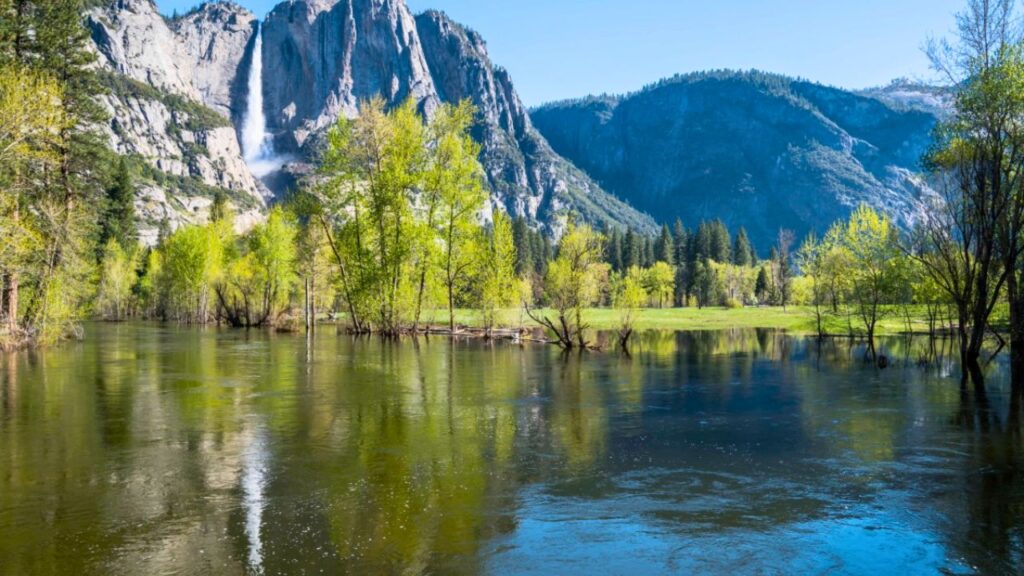
Yosemite Falls isn’t just one waterfall, but three distinct sections plunging a total of 2,425 feet, making it the highest in North America. Experiencing it involves a choice: the easy stroll to the base of Lower Yosemite Fall or the strenuous, thigh-burning climb to the top of Upper Yosemite Fall.
- Lower Yosemite Fall Trail:
- Distance: 1-mile loop
- Elevation Gain: Minimal (approx. 50 feet)
- Difficulty: Easy, paved, wheelchair accessible (with assistance)
- Best Time: Spring (April-June) for maximum flow, but flows year-round (can be a trickle in late fall).
- The Experience: This short walk brings you right to the base of the powerful 320-foot Lower Fall. You’ll feel the mist, hear the roar, and get fantastic photo opportunities. I recall standing on the footbridge one May morning, the sheer volume of water crashing down was almost overwhelming – a visceral reminder of nature’s power, soaking me happily despite my rain jacket. It’s a perfect introduction for families and those short on time.
- Upper Yosemite Fall Trail:
- Distance: 7.2 miles roundtrip
- Elevation Gain: 2,700 feet
- Difficulty: Strenuous
- Best Time: Spring/Early Summer (May-July). Trail can be icy/snowy in winter/early spring.
- The Experience: This is a serious hike. A relentless series of switchbacks climbs steeply up the canyon wall. The views down into Yosemite Valley get increasingly spectacular as you ascend. You’ll pass Columbia Rock (a worthy destination itself) before continuing the grueling climb. Reaching the top is a true accomplishment. You can walk to a viewpoint perilously close to the precipice where Yosemite Creek begins its massive plunge. The feeling of vertigo mixed with triumph is unforgettable. Remember packing extra water and snacks for this one – I learned that lesson the hard way on a hot July day!
| Feature | Lower Yosemite Fall Trail | Upper Yosemite Fall Trail |
| Distance | 1 mile loop | 7.2 miles roundtrip |
| Elevation Gain | ~50 ft | 2,700 ft |
| Difficulty | Easy | Strenuous |
| Time Needed | < 1 hour | 6-8 hours |
| Highlight | Base view, mist | Top-down view, challenge |
2. The Mist Trail: Up Close and Personal with Vernal & Nevada Falls
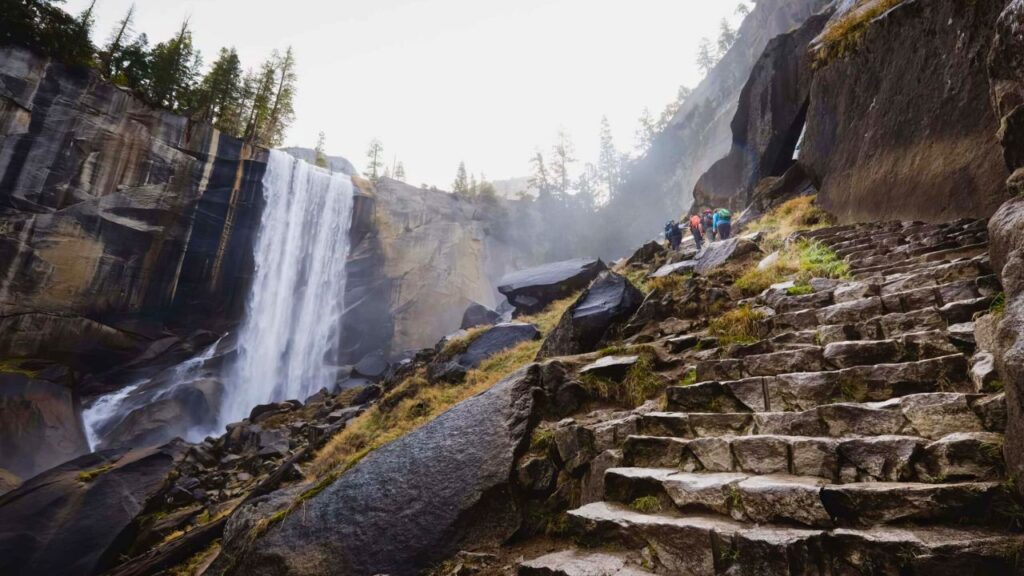
Perhaps Yosemite’s most famous hike, the Mist Trail delivers exactly what it promises: a thorough soaking as you climb alongside two magnificent waterfalls on the Merced River.
- Distance: 3 miles roundtrip to Vernal Fall footbridge; 5.4 miles roundtrip to top of Nevada Fall (via Mist Trail); ~7 miles loop via John Muir Trail return.
- Elevation Gain: 1,000 feet to top of Vernal Fall; 2,000 feet to top of Nevada Fall.
- Difficulty: Moderate to Vernal Fall; Strenuous to Nevada Fall.
- Best Time: Spring/Early Summer (May-June) for peak flow and intense mist. Water levels decrease significantly by late summer/fall. The stone steps can be very slippery when wet.
- The Experience: The paved path starts easily, leading to the Vernal Fall footbridge (a great turnaround point for an easier hike). Beyond this, the real Mist Trail begins: over 600 steep, narrow granite steps ascend directly alongside Vernal Fall (317 feet). In peak flow, the spray is blinding and drenching – waterproof gear is essential, not optional! It feels like climbing through a hurricane, exhilarating and slightly mad. I remember laughing uncontrollably with fellow hikers as we emerged at the top, looking like drowned rats but buzzing with adrenaline. The view from the brink of Vernal Fall, looking down into the churning pool below, is dizzying. Continuing onward, the trail climbs further to the top of the massive Nevada Fall (594 feet). The panorama here, encompassing Liberty Cap and the back of Half Dome, is breathtaking. Many hikers choose to return via the John Muir Trail for different scenery and a slightly less steep descent, offering iconic views back towards Nevada Fall.
3. Bridalveil Fall: An Elegant Welcome
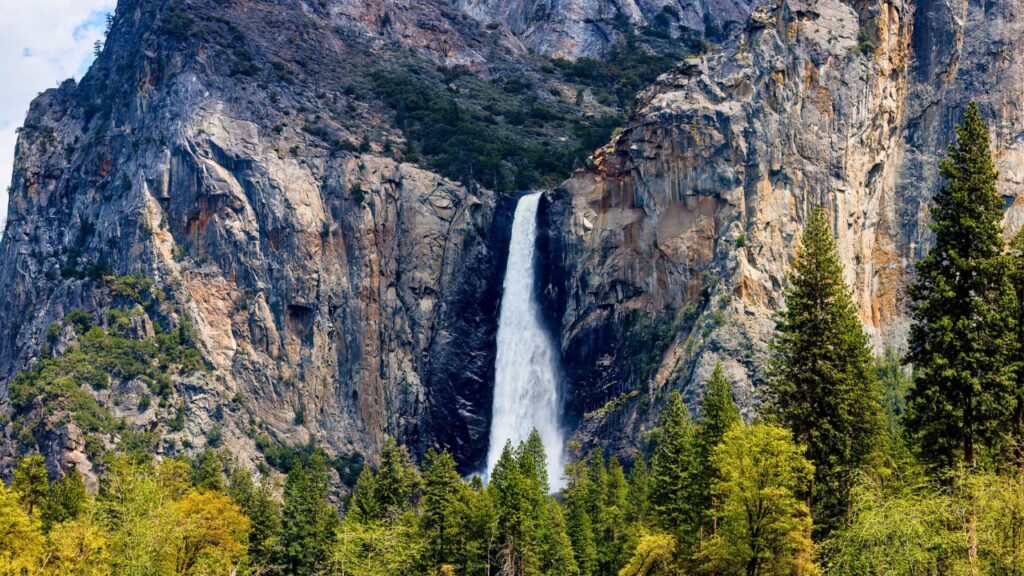
Often the first major waterfall visitors see upon entering Yosemite Valley from the west, Bridalveil Fall (620 feet) is known for its delicate, swaying appearance, especially when breezes catch the water.
- Distance: 0.5-mile roundtrip loop
- Elevation Gain: Minimal (approx. 80 feet)
- Difficulty: Easy, paved trail
- Best Time: Spring (April-June) has the most robust flow, but it typically flows year-round, though sometimes diminishing significantly in late fall. It’s particularly beautiful on windy days when the “veil” effect is most pronounced.
- The Experience: This is a quick, easy walk to a viewing platform near the base. Depending on the wind and flow, you can get quite a bit of spray. I once visited on a blustery spring afternoon, and the fall seemed alive, dancing side-to-side, living up to its name perfectly. It’s a lovely, accessible taste of Yosemite’s waterfall grandeur.
Northern California: Redwood Forests and Volcanic Wonders
Moving north, the landscape changes, offering waterfalls set against lush redwood forests and unique volcanic terrain.
4. Burney Falls: The Eighth Wonder of the World
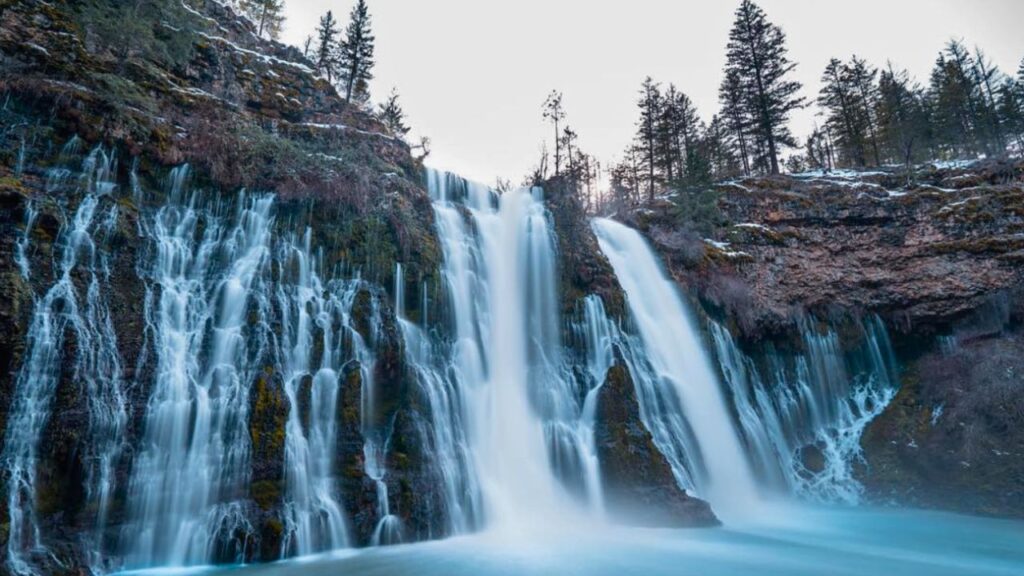
Located in McArthur-Burney Falls Memorial State Park, Burney Falls is often lauded (supposedly even by President Theodore Roosevelt) as the “eighth wonder of the world.” Once you see it, you understand why. It’s not exceptionally tall (129 feet), but its breadth and unique source are captivating. Water emerges not only from Burney Creek plunging over the cliff but also through the porous, moss-covered volcanic rock face itself, creating hundreds of shimmering outlets.
- Distance: 1.3-mile Falls Loop Trail
- Elevation Gain: Approx. 150 feet
- Difficulty: Easy to Moderate (some stairs and incline on the loop)
- Best Time: Year-round! Unlike many Sierra falls, Burney Falls is spring-fed and maintains a remarkably consistent flow (around 100 million gallons daily) throughout the year. Spring offers lush greenery, fall provides some color contrast, and winter can occasionally bring a dusting of snow.
- The Experience: The main overlook near the parking lot offers a stunning first impression. But definitely take the paved path down to the base. Standing there, enveloped by the sound and the cool, misty air, watching water seemingly weep from the entire cliff face is truly magical. The full loop trail takes you across a bridge downstream and then climbs back up the other side for different perspectives. I remember visiting on a quiet autumn weekday; the low angle of the sun created dozens of tiny rainbows in the mist – it felt like stepping into a fairytale.
5. McCloud River Falls Trail: A Trio of Treasures
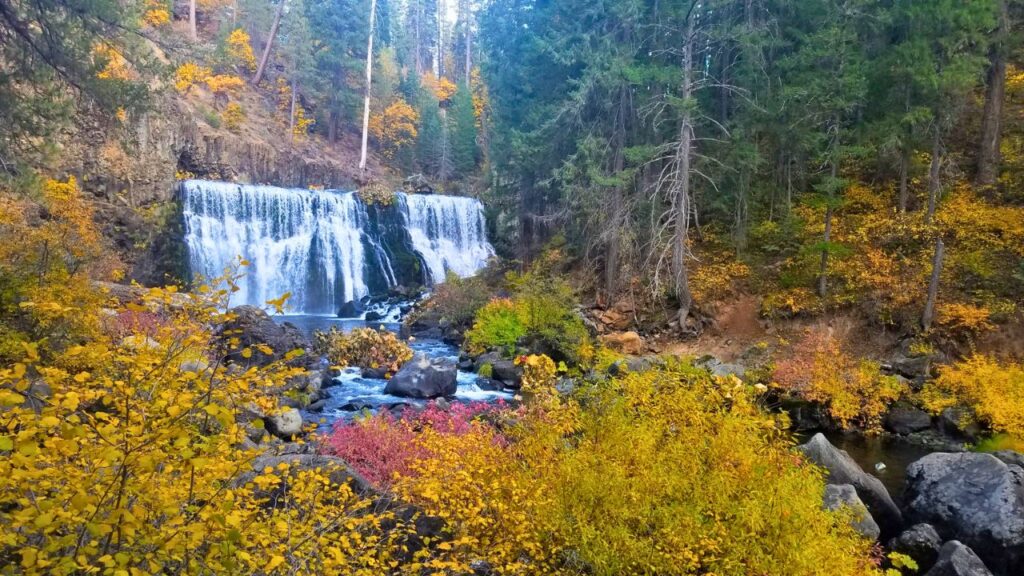
Near the town of McCloud and Mount Shasta, this trail follows the McCloud River, showcasing three distinct and beautiful waterfalls: Lower, Middle, and Upper Falls.
- Distance: ~3.8 miles roundtrip (to see all three and return)
- Elevation Gain: Approx. 300 feet
- Difficulty: Easy to Moderate
- Best Time: Spring/Early Summer for highest flow, but beautiful year-round. Summer offers swimming opportunities (use caution!). Fall colors can be lovely along the river.
- The Experience: You can drive to overlooks for each fall, but hiking the trail connecting them is far more rewarding.
- Lower Falls: The smallest, a cascade into a popular swimming hole with picnic areas. Very accessible.
- Middle Falls: Arguably the most scenic. A broad, powerful curtain of water plunging about 50 feet into a large, turquoise pool surrounded by dramatic rock walls. There’s a great overlook, and a steeper path leads closer to the base. I spent a blissful hour here once, just sitting on the rocks, mesmerized by the sheer power and beauty. It’s a perfect picnic spot.
- Upper Falls: Different in character. Water chutes through a narrow constriction in the rock before tumbling into a pool below. There’s an overlook platform offering a great view. The trail between the falls winds pleasantly through the forest, often alongside the river. It’s a fantastic hike offering variety and multiple rewards.
| Waterfall | Height (Approx) | Key Feature | Accessibility |
| Lower McCloud | 12 ft | Swimming Hole | Easiest |
| Middle McCloud | 50 ft | Broad Curtain, Pool | Moderate Path |
| Upper McCloud | 30 ft | Chute through Rock | Overlook |
6. Berry Creek Falls Trail: Redwoods and Waterfalls (Big Basin Redwoods State Park – Note Park Status)
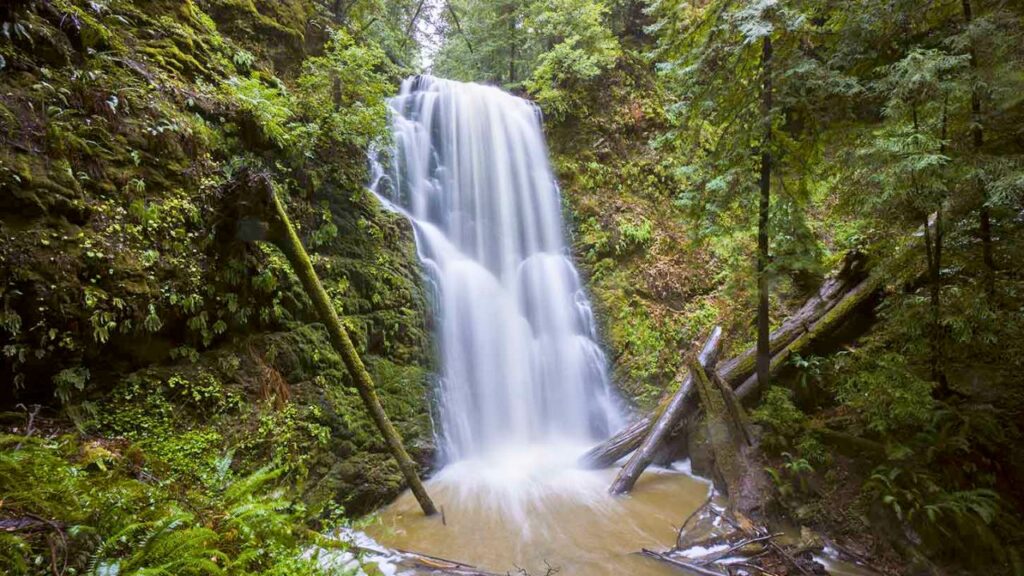
Important Note (as of April 2025): Big Basin Redwoods State Park suffered extensive damage in the 2020 CZU Lightning Complex fire. While recovery efforts are ongoing and limited access is returning, the full trail system, including the popular route to Berry Creek Falls, may still have closures or require reservations. Always check the official California State Parks website for the absolute latest conditions and access information before planning a trip.
Assuming future full access, this is a classic Northern California hike combining towering old-growth redwoods with a series of beautiful waterfalls.
- Distance: ~10.5 miles roundtrip (via Skyline to the Sea and Berry Creek Falls trails)
- Elevation Gain: Approx. 1,800 feet (mostly on the return)
- Difficulty: Strenuous
- Best Time: Spring (March-May) for best water flow and fewer crowds than summer. Winter flows are high but trails can be muddy.
- The Experience: This is a commitment, a long day hike, but utterly rewarding. The journey starts under the canopy of giants, the air cool and smelling of damp earth and redwood duff. The trail eventually descends into the lush canyon of Waddell Creek, following it upstream. The anticipation builds until you reach the first of the falls, Silver Falls, where the water slides gracefully down a smooth rock face. Shortly after is the main event: Berry Creek Falls (approx. 70 feet), plunging dramatically into a grotto surrounded by ferns and redwoods. It feels like a hidden sanctuary. Continuing briefly upstream reveals the multi-tiered Golden Falls. The memory of emerging from the deep shade of the redwoods into the sunlit, misty pocket of Berry Creek Falls after a long hike is one I cherish – it felt like discovering a secret world. The climb back out is challenging but filled with the satisfaction of the beauty witnessed.
Big Sur Coast: Where Mountains Meet Sea
The iconic Big Sur coastline offers dramatic cliffs, coastal redwoods, and some truly unique waterfall experiences.
7. McWay Falls: The Iconic Tidefall
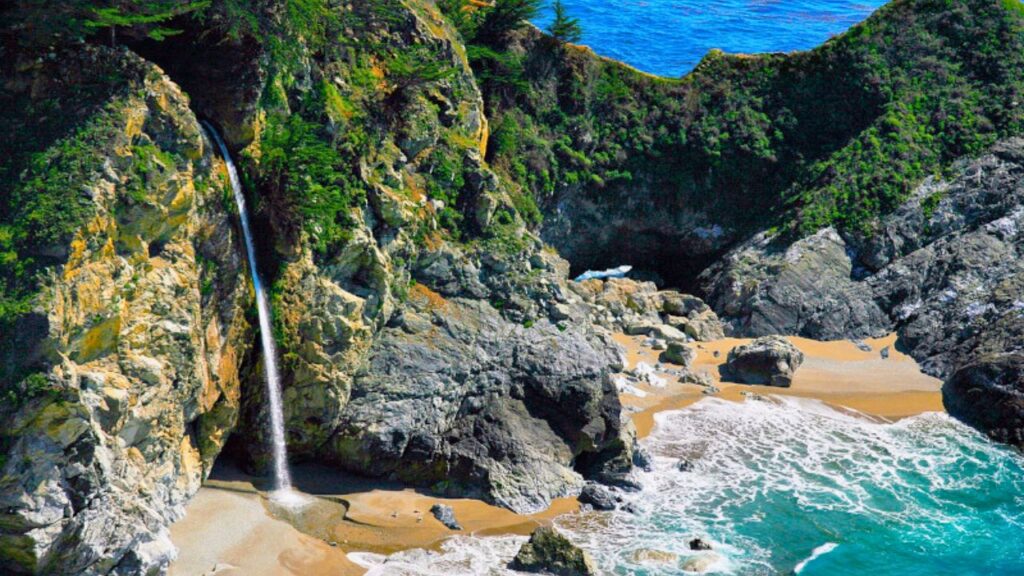
Perhaps one of the most photographed spots in California, McWay Falls in Julia Pfeiffer Burns State Park is famous for being a “tidefall” – a waterfall that plunges directly onto the beach or into the ocean, depending on the tide.
- Distance: 0.6 miles roundtrip (Overlook Trail)
- Elevation Gain: Minimal
- Difficulty: Easy
- Best Time: Year-round. The view is always stunning. Best light is often mid-day when the sun illuminates the cove, or late afternoon/sunset.
- The Experience: It’s crucial to know that access to the beach and cove below is strictly prohibited to protect the sensitive environment. The viewpoint is easily reached via a short, mostly flat trail starting from the parking area (or across Highway 1 if parking along the road). The trail winds slightly downhill to an overlook offering a postcard-perfect view of the 80-foot waterfall cascading onto a pristine, inaccessible beach in a turquoise cove. I remember leaning on the railing, watching the waves crash just feet from where the freshwater stream met the sand – it’s impossibly picturesque, a scene straight out of a dream. While it’s not a hike in the traditional sense, no list of California waterfalls is complete without it.
8. Limekiln Falls Trail: History Amongst the Redwoods
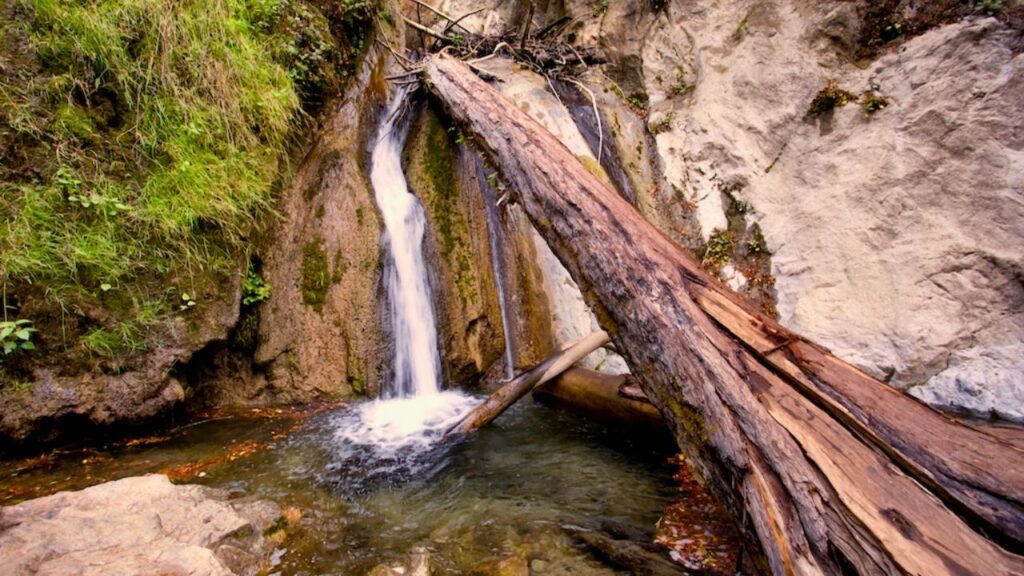
Limekiln State Park offers a delightful combination of coastal access, redwood groves, and a charming waterfall hike that includes fascinating historical remnants.
- Distance: ~1.5 miles roundtrip
- Elevation Gain: Approx. 300 feet
- Difficulty: Easy to Moderate
- Best Time: Year-round, but spring offers the lushest greenery and best flow.
- The Experience: The trail follows Limekiln Creek inland, quickly transitioning from the coastal scrub into a cool, shaded redwood canyon. A fascinating detour leads you to four towering, beautifully preserved historic lime kilns used in the late 19th century to process limestone quarried nearby. Back on the main trail, you’ll make a couple of simple stream crossings (potentially requiring rock-hopping or getting feet wet depending on the season) before reaching the trail’s end at Limekiln Falls. It’s a delicate, multi-tiered cascade tumbling about 100 feet down a fern-draped rock face into a small pool. The contrast between the sunny coast nearby and this cool, shaded, historic canyon is striking. I recall the quiet serenity here, the sound of the falls mixing with the rustle of redwood needles, feeling worlds away from Highway 1 just a short distance back. Check park status before visiting, as Big Sur parks can be subject to closures due to fire or landslides.
Southern California: Unexpected Cascades in Arid Lands
While known more for beaches and deserts, Southern California hides some surprising and rewarding waterfall hikes, often requiring a bit more effort or planning, especially regarding heat and water levels.
9. Eaton Canyon Falls: An Urban Oasis
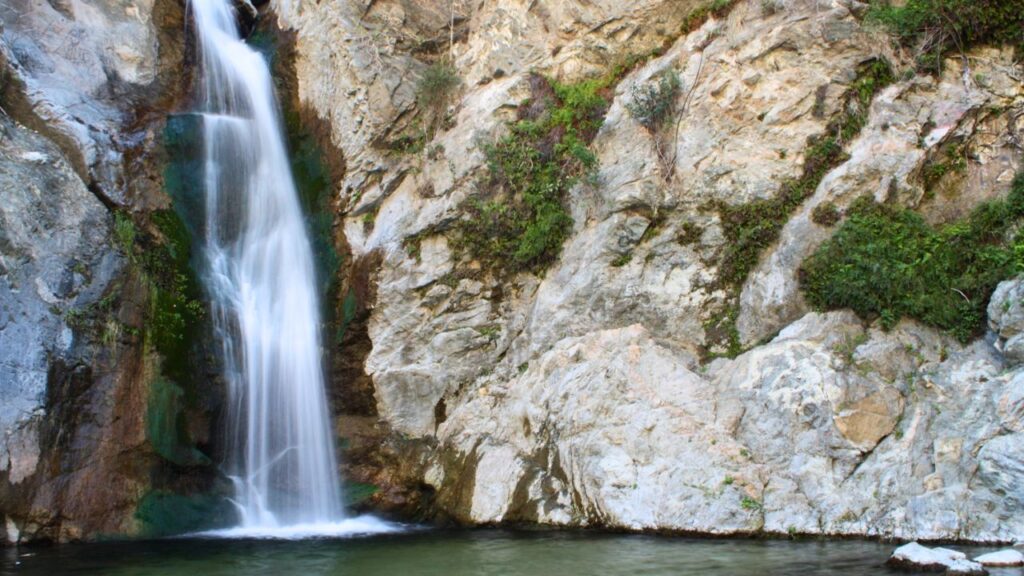
Surprisingly close to Pasadena and Los Angeles, Eaton Canyon Natural Area offers a popular and relatively easy escape to a lovely waterfall.
- Distance: ~3.5 miles roundtrip
- Elevation Gain: Approx. 500 feet
- Difficulty: Easy to Moderate (due to stream crossings and uneven terrain)
- Best Time: Winter and Spring (December-May) after rains for the best flow. Can be a trickle or dry in summer/fall. Avoid hiking during or immediately after heavy rain due to flash flood risk. Weekdays are best to avoid significant crowds.
- The Experience: The hike starts on a wide, exposed trail before dropping into the shaded canyon. The adventure begins as the trail becomes less defined, requiring multiple stream crossings. These are usually straightforward rock-hops or shallow wades, but they add a fun element. I remember navigating these crossings with a group of friends, laughing as one inevitably slipped on a slick rock (no harm done!). The trail culminates at the base of Eaton Canyon Falls, a roughly 40-foot waterfall plunging into a shallow pool surrounded by canyon walls. It feels remarkably wild for being so close to the city. Its popularity means you’ll likely share the spot, but it’s still a refreshing escape.
10. Sturtevant Falls: A Historic Trail in the San Gabriels
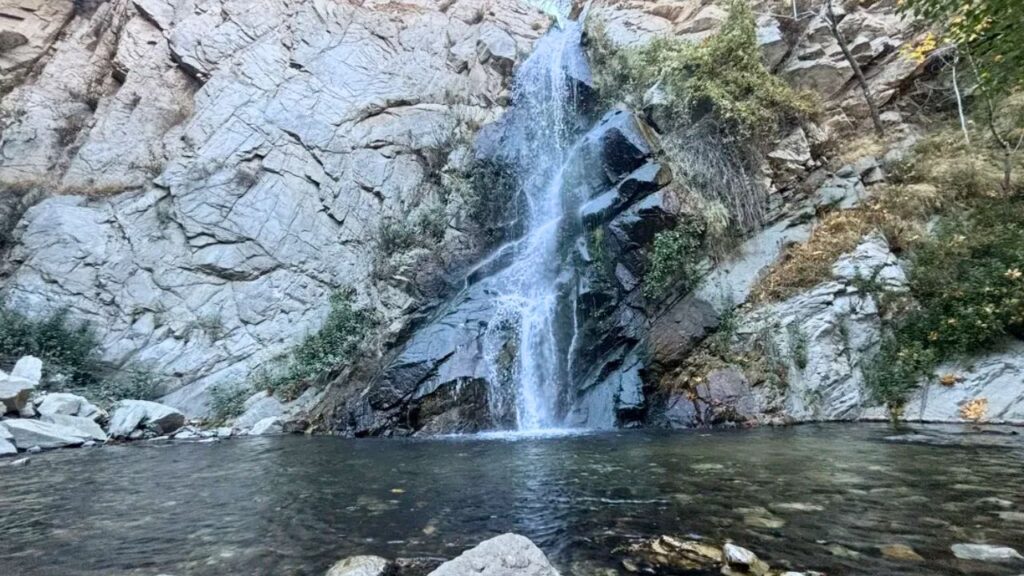
Nestled deep within the Angeles National Forest, the hike to Sturtevant Falls feels like stepping back in time, passing historic cabins (some still privately owned) from the “Great Hiking Era” of the early 20th century.
- Distance: ~3.3 miles roundtrip
- Elevation Gain: Approx. 700 feet (mostly on the return)
- Difficulty: Moderate
- Best Time: Winter/Spring for water flow. Summer can be hot, but the canyon is mostly shaded. Check Angeles National Forest alerts for trail status and potential Adventure Pass requirements.
- The Experience: Starting from the Chantry Flat parking area (which fills extremely early, especially on weekends!), the hike begins with a paved downhill path before turning onto the Gabrielino Trail. You’ll follow Santa Anita Creek, crossing it several times on charming bridges, passing the rustic cabins tucked amongst the trees. The air is cool and smells of oak and bay laurel. The trail leads directly to the base of Sturtevant Falls, a beautiful 50-foot cascade tumbling over a mossy cliff into a serene pool. I remember feeling a sense of peace here, the historical context adding a layer of romance to the natural beauty. It’s a popular spot, but the journey through the shaded canyon makes it feel like a proper mountain escape.
11. Cedar Creek Falls: Dramatic Punchbowl (Permit Required!)
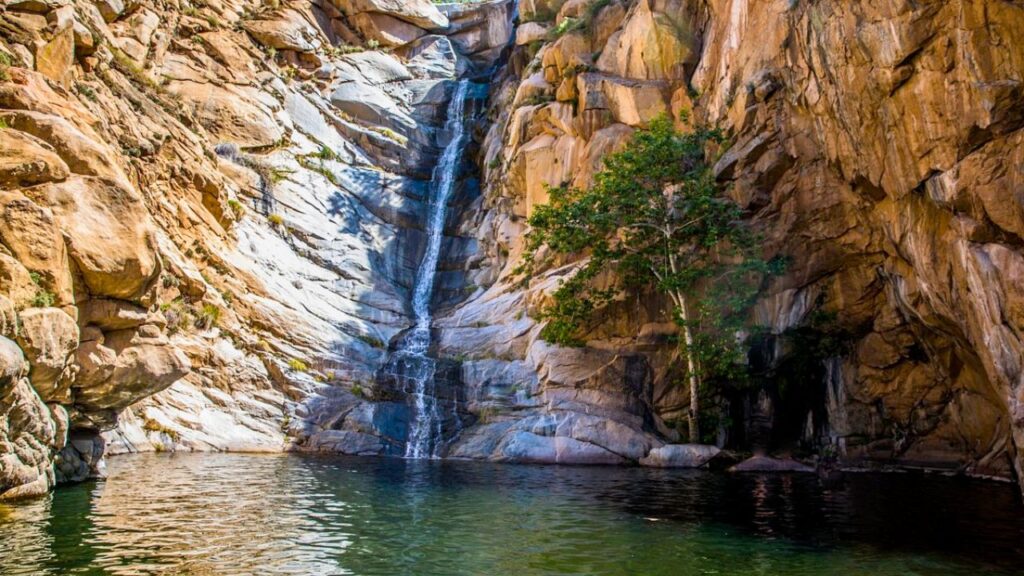
Located in the Cleveland National Forest east of San Diego, Cedar Creek Falls is one of Southern California’s most spectacular waterfalls, plunging dramatically into a large, amphitheater-like swimming hole. However, accessing it requires planning and serious caution.
- Distance: ~5.6 miles roundtrip (from San Diego River Gorge Trailhead)
- Elevation Gain: Approx. 1,100 feet (all on the strenuous uphill return)
- Difficulty: Strenuous (due to heat exposure and the uphill climb out)
- Best Time: Winter/Spring (Nov-May) when temperatures are cooler and water flow is better. Summer is dangerously hot and strongly discouraged.
- PERMIT REQUIRED: A permit must be obtained in advance via recreation.gov. Rangers patrol, and access is strictly controlled.
- CRITICAL SAFETY WARNING: This hike is notorious for heat-related illnesses and rescues. There is very little shade. Start early, bring excessive amounts of water (at least 1 gallon per person), wear sun protection, and know your limits. Sadly, fatalities have occurred here. Cliff jumping is illegal and extremely dangerous due to submerged rocks.
- The Experience: The hike begins with a relentless downhill trek on an exposed, chaparral-covered hillside with expansive views. The descent seems easy, but you know you have to climb back out. Reaching the canyon floor, the trail follows Cedar Creek to the stunning falls. The 80-foot waterfall cascades into a large, inviting pool surrounded by high cliffs – a true oasis. Taking a (safe) dip in the cool water is incredibly refreshing after the hot hike in. My strongest memory isn’t just the beauty of the falls, but the intensity of the hike out under the afternoon sun. It hammered home the importance of preparation – we carried extra water and took frequent breaks in the limited shade, and we were grateful we did. It’s a magnificent destination, but demands respect and responsible planning.
The Enduring Allure of the Cascade
From the thunderous giants of Yosemite to the hidden gems tucked away in coastal canyons, California’s waterfalls offer an incredible diversity of experiences for hikers of all levels. Each trail tells a story, each cascade sings a different song. There’s a profound sense of accomplishment in reaching a waterfall after a rewarding hike, a moment of connection with the raw beauty and power of the natural world. The sound of rushing water is calling. Go answer it.
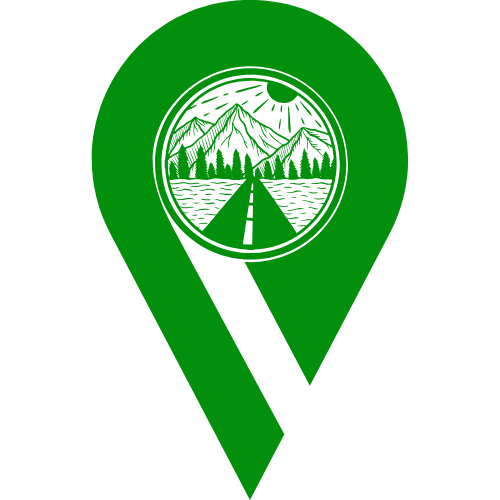
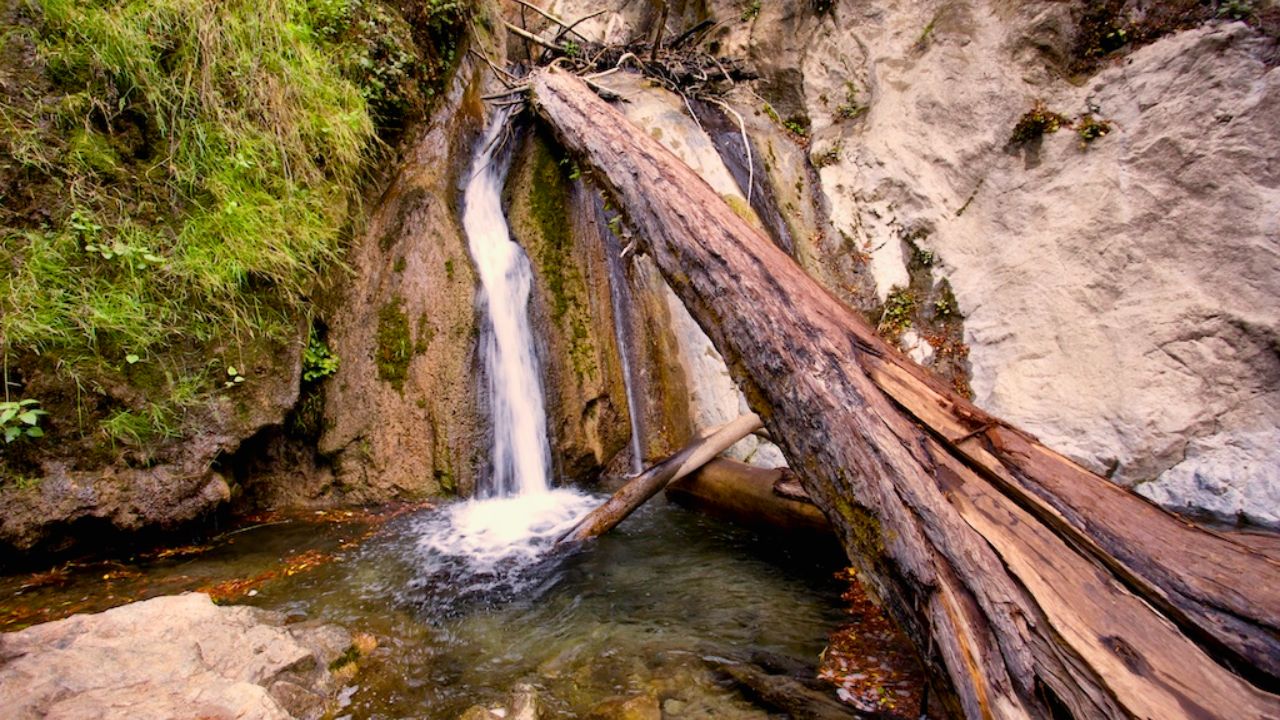
Leave a Reply